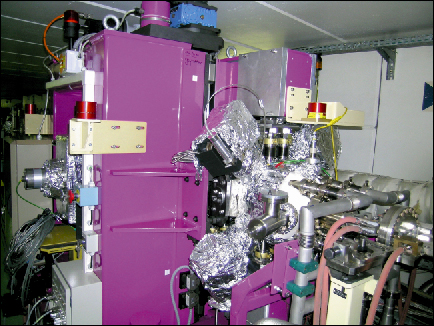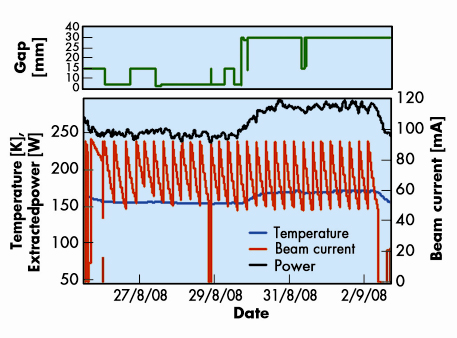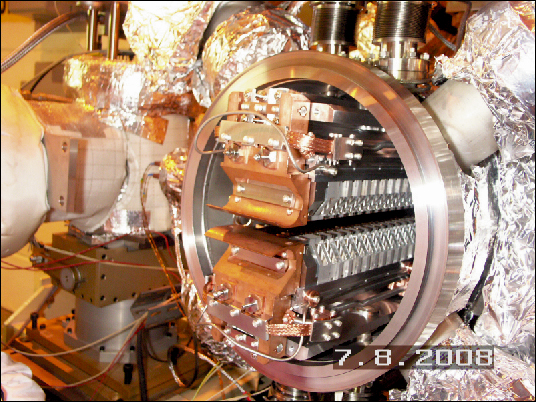- Home
- Users & Science
- Scientific Documentation
- ESRF Highlights
- ESRF Highlights 2008
- Accelerator and X-ray Source
- Operation of a cryogenic in-vacuum undulator
Operation of a cryogenic in-vacuum undulator
A cryogenic permanent magnet undulator (CPMU) offers increased peak field for a given magnetic gap and period allowing the extension of the high brilliance undulator radiation to higher photon energies beyond that available from an in-vacuum undulator. To make the most of the advantages of a CPMU, the magnetic material must be selected with a maximum remanence and thus a low coercivity. All in-vacuum undulators in operation at the ESRF are baked above 100°C after installation on the ring in order to minimise the Bremstrahlung sent to the beamline. Unfortunately, optimisation of a CPMU results in the selection of low coercivity magnetic material which prevents such baking. To minimise the risk, an initial CMPU prototype was developed which made use of magnetic material that can be baked, at the expense of a reduced field performance. In January 2008, the prototype CPMU was installed in the ID6 straight section (See Figure 170). This undulator has a period of 18 mm and a magnetic length of 2 m. During 2007, the undulator was carefully measured with a specially designed magnetic measuring bench operated in-vacuum with the magnetic assembly at cryogenic temperature [1]. The measurements confirmed the predicted temperature of 150 K which corresponds to the maximum field. Cryogenic cooling is based on a liquid nitrogen closed loop, identical to the system used in many ESRF beamlines for the cooling of cryogenic monochromators. The installed device is connected to a cryo-pump system located in the technical gallery with a cryogenic line of 50 m.
 |
|
Fig. 170: The CPMU Installed in the ID6 straight section. |
Temperature measurements on the undulator rely on 20 thermocouples distributed along the magnetic assembly. The power extracted by the cryogenic loop is derived from the measurements of the differential pressure and temperature of the liquid nitrogen between the input and output of the cryogenic pump. Figure 171 shows the average temperature of the undulator (blue) and power extracted by the cryogenic loop (black) in 16 bunch mode. The upper curve (green) corresponds to the gap of the undulator. It reveals the strong dependence of the magnet temperature as a function of the undulator gap. Both temperature and extracted power are at their maximum for a gap which is fully opened (30 mm). This feature has been observed with other types of filling patterns. It is rather unexpected and it is suspected that this originates from higher-order modes (HOM) of the radio frequency field resonating in the undulator tank. Table 6 presents the average temperature of the undulator and power extracted by the cryogenic loop for various filling modes and gap settings. High beam induced power of 105 W is observed with a filling pattern corresponding to the filling pattern of the hybrid mode.
 |
|
Fig. 171: Average temperature of the CPMU (blue) and power extracted by the cryogenic loop (black) versus time in the 16 bunch mode. The undulator gap is shown in the upper curve (green). |
 |
|
Table 6: Measured average temperature of the magnetic assembly and power extracted by the cryogenic loop in different filling modes and with various undulator gaps. The last column presents the net power deposited by the beam. |
The measured cryogenic power of 210 W without beam originates from conduction and radiation losses inside the undulator vessel (150 W) plus the losses in the cryogenic line (60 W).
The average observed temperature of the undulator with beam varies from 151 K to 177 K depending on the filling pattern. This corresponds to a change of peak magnetic field smaller than 0.4% [2]. A feature of major importance is the variation of temperature along the 2 metre-long magnet assemblies. This effect was carefully studied during the magnetic measurements. A temperature gradient has an impact on the phase error in a similar manner to a gap variation along the structure (tapering). It has been observed that to reach a phase error of 2.5 degrees rms, a longitudinal temperature gradient smaller than 2 K/m must be obtained. Note that the phase error originating from a longitudinal temperature gradient can be compensated for by a mechanical gap tapering. Initial observations showed a gradient of 7 K/m in the hybrid filling mode. Such a large gradient was the consequence of poor thermal contact between the cooling pipes and the copper blocks located at the entrance of the undulator (see Figure 172). The temperature gradient was later reduced to 2 K/m following the installation of a flexible thermal connection during the summer shutdown.
 |
|
Fig. 172: Entrance of the CPMU. The installation of a flexible thermal connection between the cooling tubes and the end copper blocks at the entrance of the undulator has reduced the temperature gradient by a factor of 3.5. |
Cooling from 300 to 150 deg K without beam has had an effect on the vacuum. It reduced the pressure by about one order of magnitude to a few 10-10 mbar. The pressure nevertheless increases with beam current to around 10-8 mbar at 200 mA of ring current, which is not significantly different to a room temperature in-vacuum undulator. The combination of a large mass of magnets and support pieces at 150 K with a low cryogenic power loss results in a long thermal time constant of 12.5 hours. As a result the cryo-pump driving the liquid nitrogen in the undulator can be switched off for a few hours and then switched on again. The temperatures fluctuates slowly but the system restores its equilibrium without any further interventions.
The conclusion of a full year of operation with beam is that the routine use of a CPMU in an ESRF beamline is compatible with the constraints imposed by storage ring operation. While further investigations will be carried out on the existing prototype, a new CPMU will be built in 2009 using higher remanence NdFeB material. The design includes a number of improvements.
References
[1] J.Chavanne et al., EPAC’08, June 08, p. 2243, http://accelconf.web.cern.ch/AccelConf/e08/papers/wepc105.pdf
[2] C. Kitegi, PhD Thesis, University Joseph Fourier, 2008.



